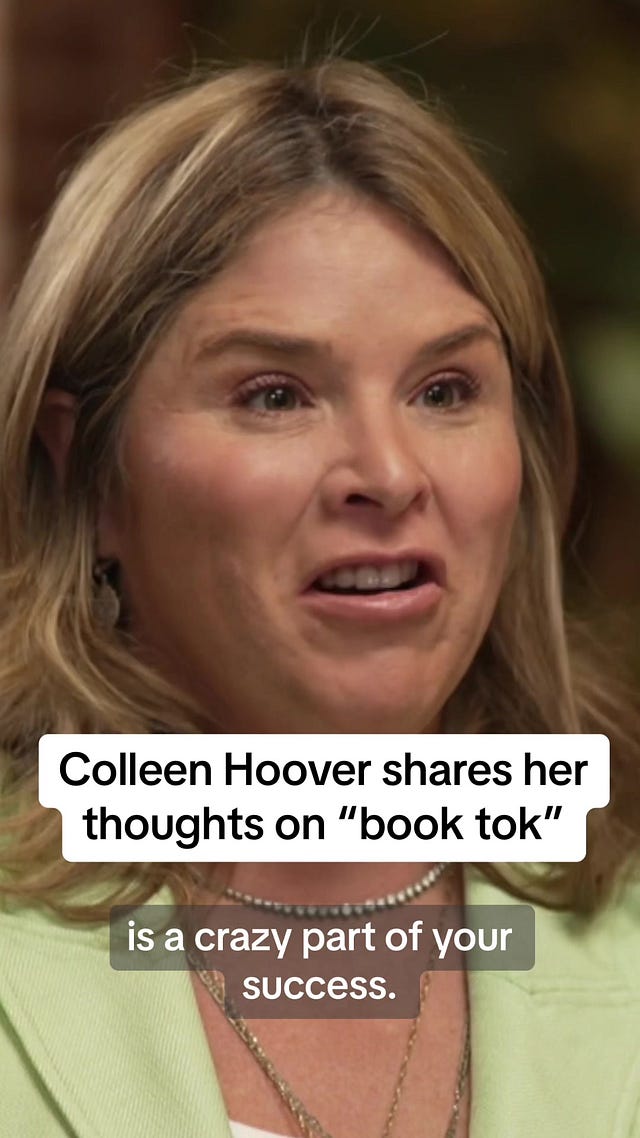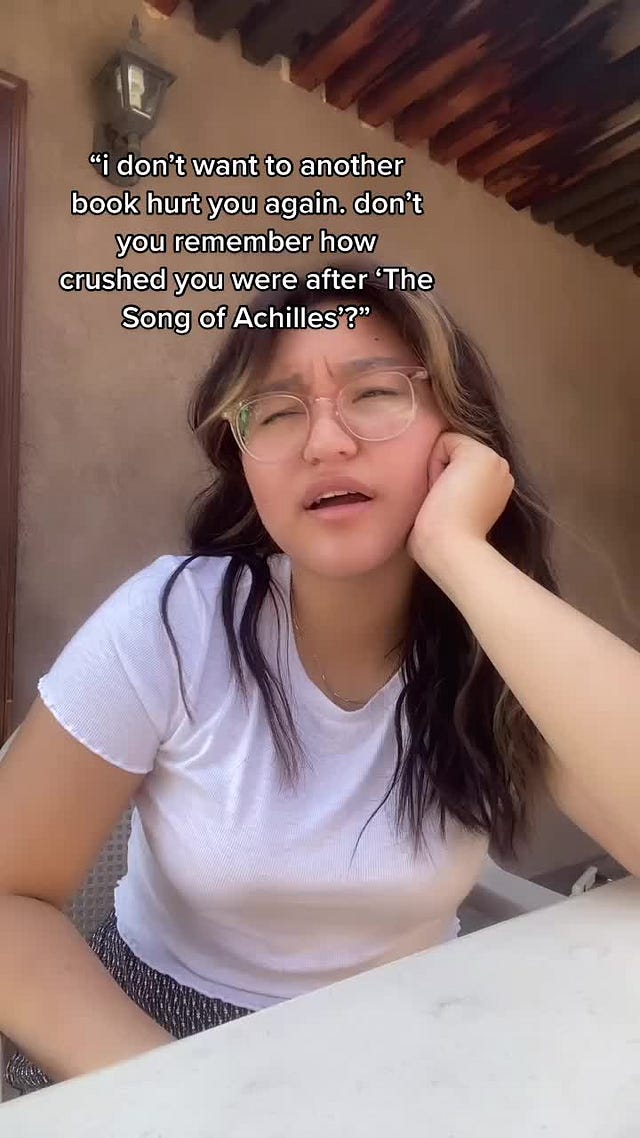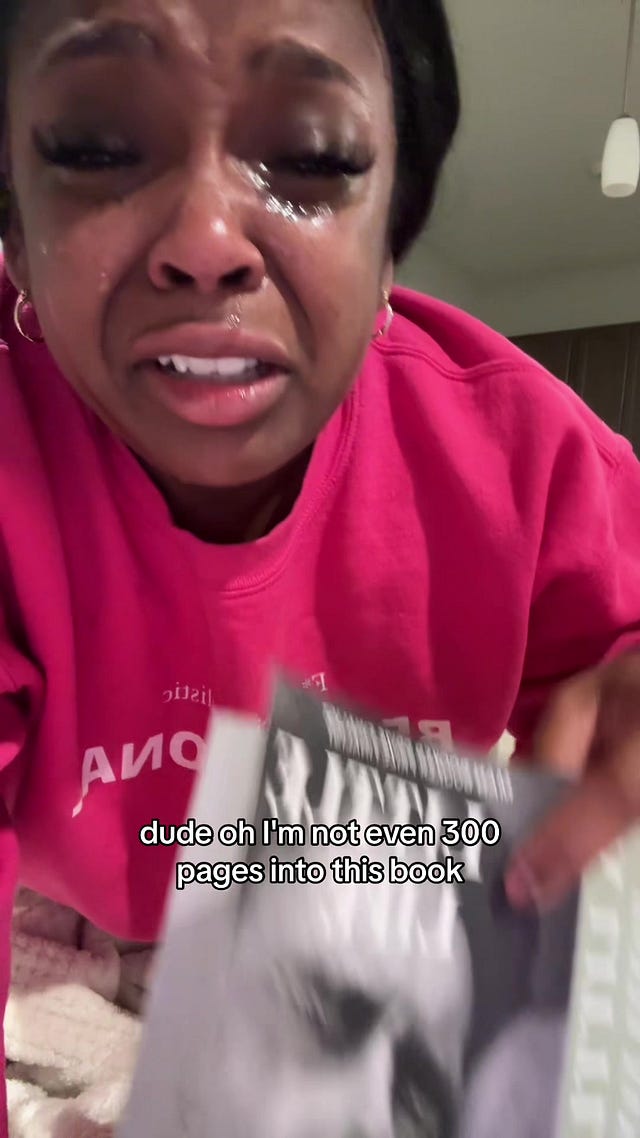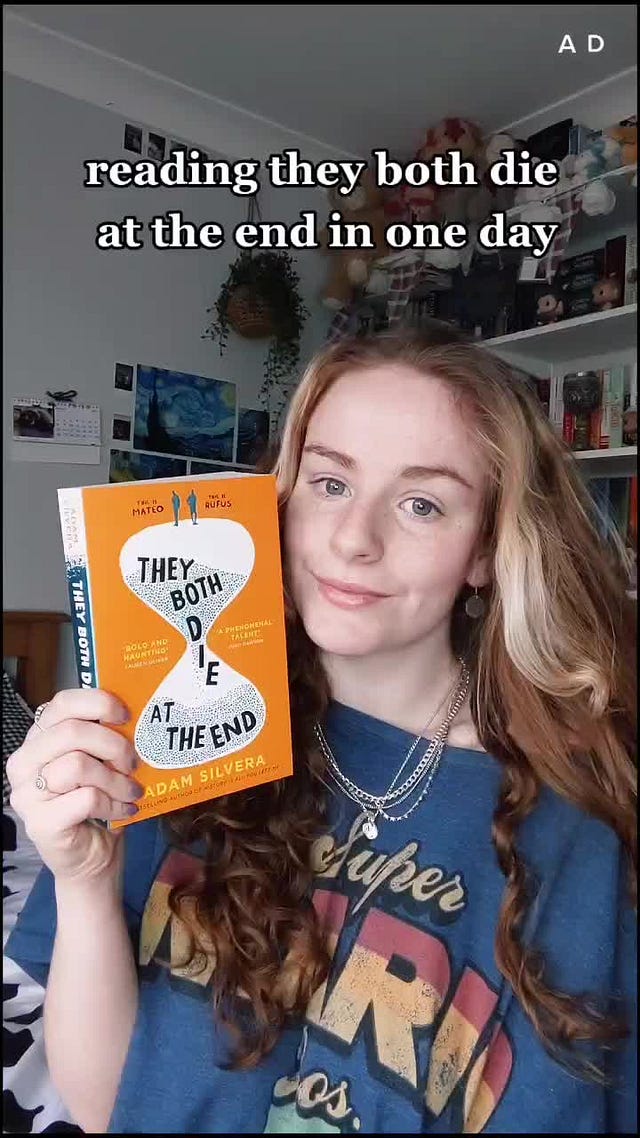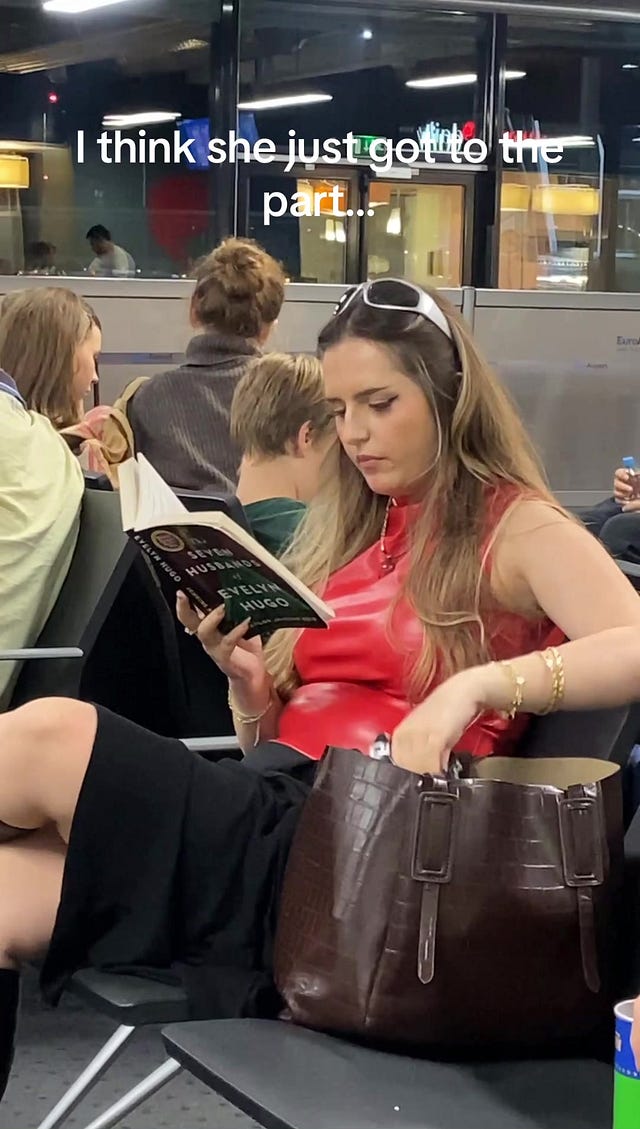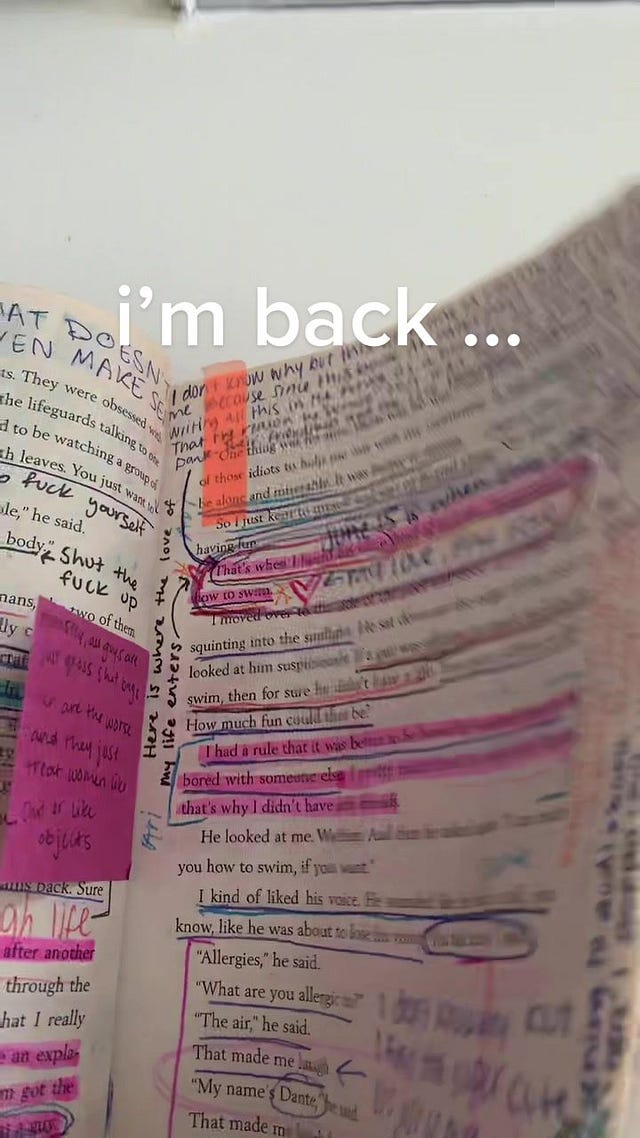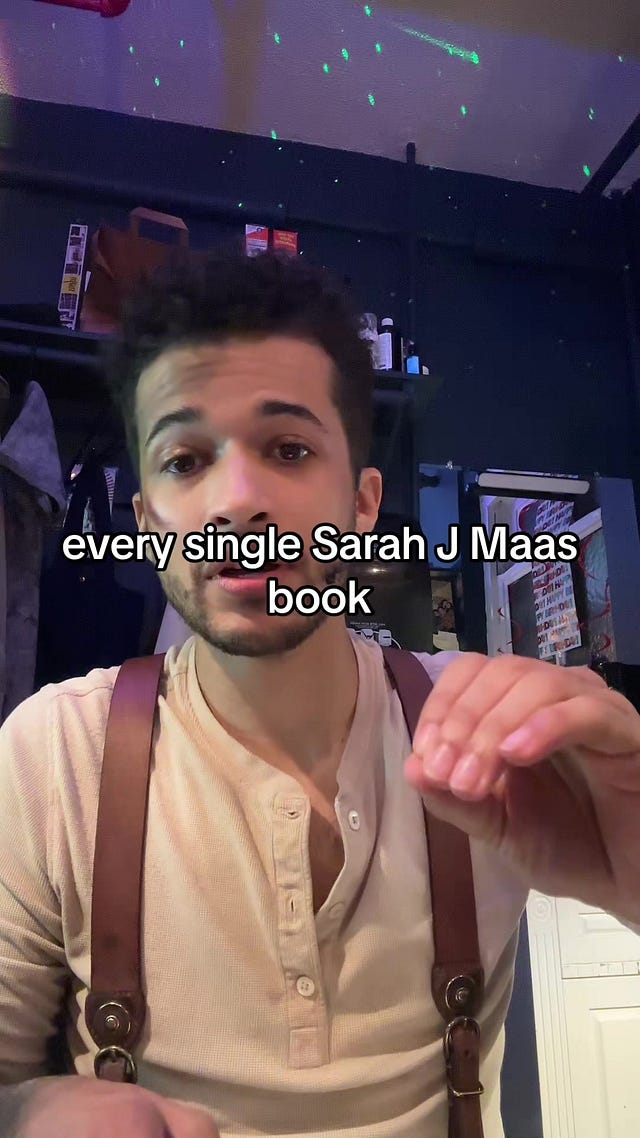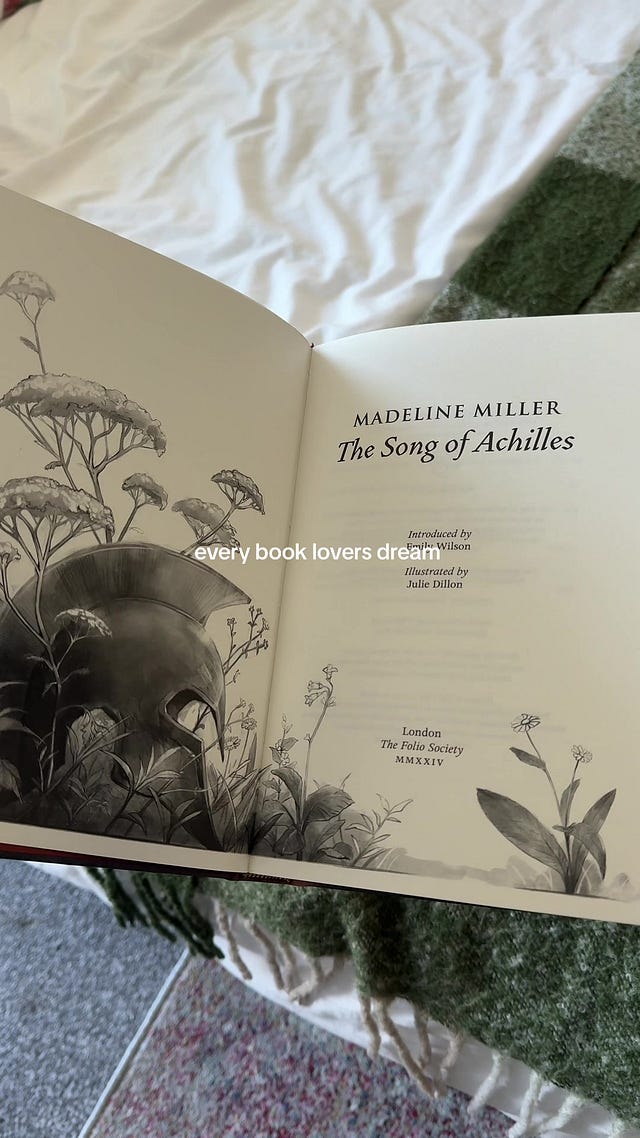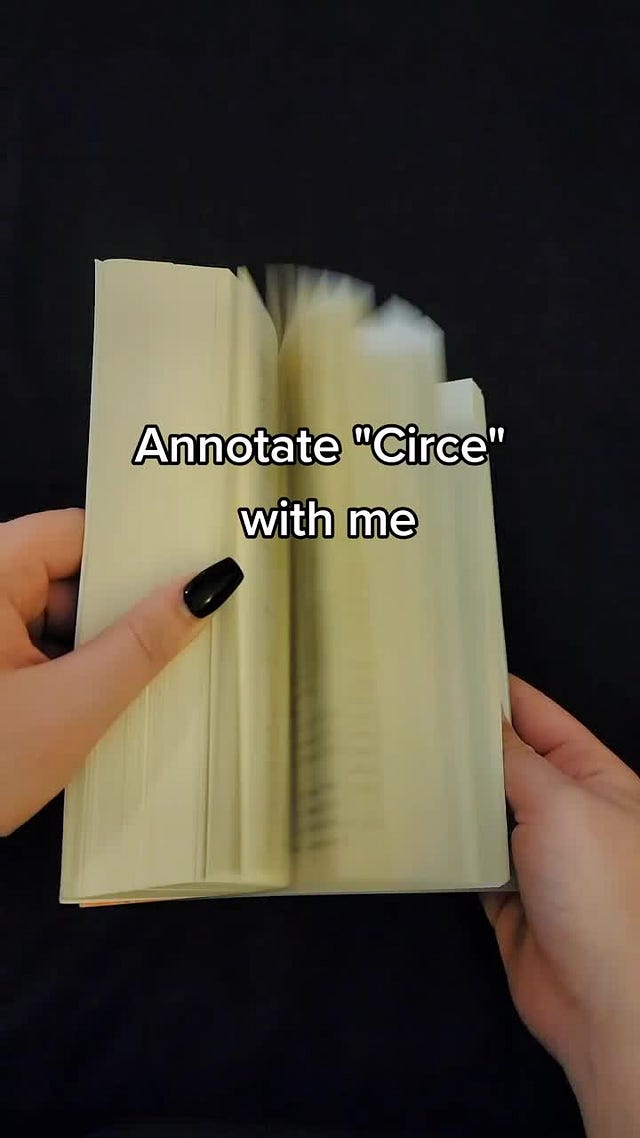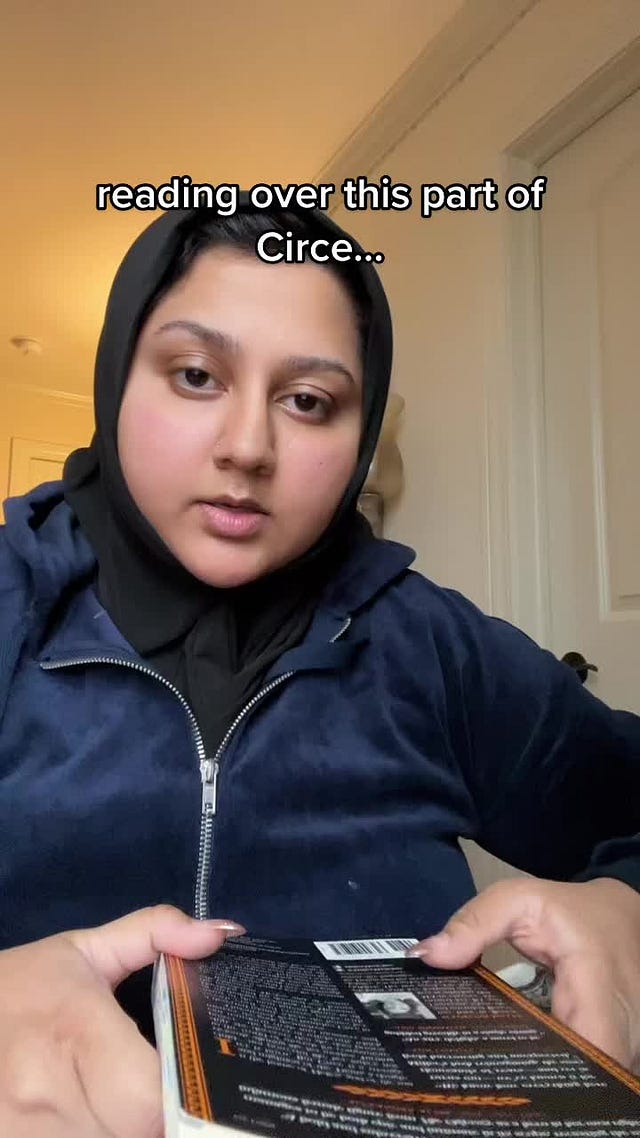#BookTok Changed the Way We Buy—Why You Should Be Paying Attention
What can we learn about how TikTok influences consumption
This isn’t a post about SaaS or CAC—but stay with us.
Lately we’ve been fascinated by the online community #BookTok.
#BookTok has completely disrupted the publishing industry’s go-to-market model, and if you sell anything—books, tools, software, services—you should be paying attention.
We wanted to understand: What can #BookTok teach us about how to modern consumers making buying decisions?
How did #BookTok disrupt publishing?
What worked and what didn’t?
And what all of us can learn about selling online in 2025.
#BookTok Created A New P2P Path to Product Discovery
For years, book sales were in-decline, with publishing execs insisting it was because people just didn’t read anymore.
The publishing industry used to control the entire go-to-market:
Controlling who gets published - publishers have always had the power to control which authors and stories get published at all
Controlling bookshelves - they use retail relationships to influence what gets bought and stocked by retailers, as well as how books are merchandised with in-store displays
PR engineering - the industry helps authors record months of interviews in-advance, all to be released the week the book launches
Bestseller list manipulation - use pre-sales and bulk-buys to juice the sales numbers during opening week
And for a while, that worked.
But what BookTok has shown us in recent years is that there’s far more demand for books than publishers realized - but that demand has shifted away from the top-down books that the industry pushes through it’s machine, into different books that gain traction thanks to a groundswell from the community.
When BookTok loves a book, it moves.
Not because it was marketed.
But because it was felt.
But BookTok exposed a fundamental truth: publishing never had a demand problem. It had a discovery problem.
Readers weren’t ignoring books—they just weren’t discovering them the way publishers expected.
It turned out people were reading—they just weren’t finding books through critics, legacy media, or Amazon’s algorithm. They were finding them through raw, emotional recommendations on TikTok.
How #BookTok Turns “Dead” Books Into Bestsellers—Years After Their Release
Traditional publishing puts expiration dates on books. If a title doesn’t hit within the first few months, it gets pulled from front shelves, buried in back catalogs, and forgotten.
But the community on #BookTok doesn’t care when a book came out. If a reader picks it up, gets destroyed by the ending, and films themselves sobbing into the camera—that book starts moving.
Exhibit A: The Rise of the Hooververse
Colleen Hoover self-published her first novel, Slammed, in 2012. For most of the 2010s, she maintained a solid—but relatively niche—presence in the indie romance scene. Her books performed well in Kindle categories and she built a loyal fanbase, but she wasn’t a household name.
Then TikTok happened.
In late 2020 and early 2021, BookTok creators began posting emotional, teary-eyed reviews of It Ends With Us—a novel she published back in 2016. Videos with titles like “this book destroyed me” and “I can’t stop crying” went viral. The #ColleenHoover hashtag quickly ballooned into the billions of views.
What happened next was unprecedented:
Hoover sold over 14.3 million books in 2022 alone, across both frontlist and backlist titles.
Six of her titles appeared on the New York Times Top 10 Bestseller List simultaneously—a feat almost unheard of for a living author.
And according to Publishers Weekly, her own BookTok content helped fuel the fire:
“Take Colleen Hoover and her nearly five billion views on TikTok for example. As I see it, Hoover’s popularity is, in large part, due to her viral videos on TikTok.”
Her backlist wasn’t just selling—it was dominating. Ugly Love (2014), November 9 (2015), Verity (2018), and Reminders of Him (2022) all surged in sales, with TikTok readers devouring her entire bibliography in rapid succession.
TikTok didn’t just make It Ends With Us a hit—it created the Hooververse, a shared universe of emotionally explosive novels that readers now treat like a lifestyle.
Exhibit B: The Song of Achilles by Madeline Miller
Published in 2011
Sat quietly on shelves for nearly a decade
Then in 2021, it exploded on BookTok
There was no movie adaptation. No celebrity endorsement. No publisher-led re-release. It won the Orange Prize for Fiction in 2012, which gave it some acclaim—but it didn’t hit NYT bestseller status until 2021, after going viral on BookTok.
It was this single TikTok video below, posted by user Selene Velez @moongirlreads_ in 2021 where she featured The Song of Achilles in a video she called “books that will make you SOB”:
 Tiktok failed to load.
Tiktok failed to load.Enable 3rd party cookies or use another browser
The video has over 6M views.
And yes, Selene’s video featured five books, not just The Song of Achilles—but Achilles was the emotional climax of the video, and the one that stuck with viewers (and dominated the comments). The video became known in the BookTok community specifically for that moment, where Selene said: “I can’t think about it without bawling.”
That line got duetted, stitched, and quoted across TikTok. It became meme-fied.
Several outlets have cited this specific video and creator as the moment Achilles began trending. For instance:
The Everyday Magazine mentions @moongirlreads_ as the origin point.
Publishers Weekly confirms the book’s NYT charting happened after BookTok attention.
The other titles mentioned didn’t go nearly as viral. Why?
The Song of Achilles had the perfect BookTok formula: tragic romance, Greek mythology, high emotional payoff, lyrical writing.
The emotional impact matched BookTok’s culture of obsession, heartbreak, and identity-building.
Other books in the video lacked that same shared catharsis, or already had saturation elsewhere (some gaining momentum from Goodreads before TikTok).
Here’s another video from the same user talking about the same book:
These videos turned into a template for other users, usually creating content along the lines of “Books That Ruined Me,” where Achilles consistently ranked #1.
These viral posts became a movement, and suddenly, this quiet 10-year-old novel reached the #1 spot on the New York Times bestseller list.
TikTok didn’t just sell this book—it resurrected it.
Exhibit C: A Little Life by Hanya Yanagihara
Published in 2015.
Acclaimed, nominated for awards, but never a mainstream blockbuster.
Until 2022, when TikTok turned it into an emotional battleground.
This book is trauma with a spine—a gut-wrenching, deeply harrowing story of friendship and pain. Some BookTok users sobbed over it, calling it life-changing. Others labeled it “trauma p*rn” and debated whether it was too much or emotionally exploitative.
The book became one of the most discussed titles on the platform—and that drove a serious sales resurgence:
TikTok videos under the hashtag #alittlelife have surpassed 116 million views (as of April 2025)
According to Penguin Books UK, A Little Life became a top-selling backlist title again in 2023 thanks to BookTok-driven sales
Waterstones, one of the UK’s largest bookstore chains, highlighted the book as a recurring bestseller in their #BookTok tables
Viral TikToks like this one from @kierralewis75 sparked massive conversation and stitched responses
 Tiktok failed to load.
Tiktok failed to load.Enable 3rd party cookies or use another browser
By 2024, A Little Life was not just back—it had become one of BookTok’s most polarizing, talked-about, and commercially successful revivals.
Love it or hate it, people couldn’t stop posting about it.
And if people are talking? People are buying.
Other BookTok Resurrections Worth Knowing
One pattern that emerges when studying other examples of this phenomenon: the books that are resurrected are often emotionally explosive, narratively intense, and tailor-made for obsession.
And the stories readers cling to? They’re often about identity, loss, redemption, and love in its most complicated forms.
They Both Die at the End by Adam Silvera (2017)
This YA novel had a modest release in 2017—well-reviewed, but not a breakout hit. It wasn’t until 2020, when TikTok users began posting tearful, heart-wrenching reactions to the ending, that the book took off.
And the numbers back it up:
In 2021, the book hit #1 on the New York Times YA Bestseller List—four years after publication.
It stayed on the NYT list for over a year straight.
Sales surged from under 5,000 units/week to over 20,000 units/week at peak, according to NPD BookScan.
The chart from BookScan shows a clear inflection point: when BookTok got a hold of it, sales skyrocketed.
It Ends With Us by Colleen Hoover (2016)
BookTok didn’t just revive this novel—it turned Colleen Hoover into a publishing juggernaut resulting in the recent It Ends With Us film adaptation starring Blake Lively and Justin Baldoni.
BookTok operates on emotional imprinting. Readers posted thousands of teary-eyed reviews. That emotional intensity created a kind of author addiction—when readers get emotionally attached to one book, they go hunting for everything else by that author.
Check out how BookTok has impacted the rest of how Colleen Hoover’s catalog:
Over 5 billion views on TikTok mentioning #ColleenHoover.
Over 14.3 million books sold in 2022 alone
At one point, six of her books were simultaneously on the New York Times Top 10 list.
Her sequel, It Starts With Us, became Simon & Schuster’s most pre-ordered book of all time, with 800,000 copies sold on launch day.
The Seven Husbands of Evelyn Hugo by Taylor Jenkins Reid (2017)
This novel quietly simmered for years—until BookTok started calling it “the queer love story you’ll never forget.” Everybody was so obsessed with this book, reading it everywhere and going viral on TikTok.
 Tiktok failed to load.
Tiktok failed to load.Enable 3rd party cookies or use another browser
Though critically acclaimed upon its 2017 release, The Seven Husbands of Evelyn Hugo didn’t achieve mainstream blockbuster status until BookTok users began spotlighting it as a must-read.
What followed was a perfect storm of obsession:
The hashtag #evelynhugo has over 550 million views on TikTok.
Users film “I just finished this and I’m emotionally wrecked” reaction videos that get hundreds of thousands of views.
Quotes from the book are everywhere on BookTok and Pinterest.
Sales surged so dramatically that the book returned to the New York Times bestseller list five years after publication.
As of 2022, it was the 2nd most-sold adult fiction book in the U.S. behind only It Ends With Us (NPD BookScan).
Aristotle and Dante Discover the Secrets of the Universe by Benjamin Alire Sáenz (2012)
This YA classic about queer Latino identity was rediscovered by Gen Z through BookTok’s love of poetic coming-of-age stories.
Originally released in 2012, Aristotle and Dante was beloved in literary circles but flew under the mainstream radar. It won awards. It built a small but devoted following. Then, a decade later, TikTok found it—and everything changed.
What happened next:
TikTok creators began posting emotional reviews under hashtags like #aristotleanddante and #bookswithbeautifulwriting, many racking up hundreds of thousands of views.
The book’s most viral themes—loneliness, masculinity, queer tenderness—struck a nerve with Gen Z readers navigating their own identities.
Sales surged leading up to the 2022 film adaptation, with publishers re-releasing special editions to meet demand.
As of 2023, the book had sold over 1.5 million copies, with the sequel (Ari & Dante Dive into the Waters of the World) becoming an instant bestseller.
Throne of Glass by Sarah J. Maas (2012)
Sarah J. Maas isn’t just an author—she’s a genre on BookTok. Her books consistently trend on #BookTok with fantasy fans posting reaction videos, fan art, and deep lore breakdowns.
 Tiktok failed to load.
Tiktok failed to load.Enable 3rd party cookies or use another browser
Throne of Glass, the first book in her fantasy series, was published in 2012 and saw steady sales over the years. But a decade later, BookTok turned Maas into something else entirely: the Beyoncé of fantasy romance. Her books aren’t just read—they’re devoured, analyzed, memed, wept over, and endlessly re-shared.
What the numbers say:
The hashtag #sarahjmaas has over 4 billion views on TikTok.
Fan-made videos about Throne of Glass, A Court of Thorns and Roses, and Crescent City routinely hit millions of views, driving new readers into entire book universes.
From January to June 2024, Maas sold 4.83 million print books in the U.S. alone, much of it attributed to BookTok virality.
Booksellers now create entire shelves dedicated to her books—because customers don’t just want one title, they want the full Maas cinematic universe.
Key Takeaway: BookTok rewards bingeable storytelling. When readers fall for a world, they want more of it.
A Pattern Emerges
After looking at all seven books, here’s what becomes crystal clear: BookTok is a behavior shift. And the ripple effects go far beyond a single viral title:
1. One Viral Book Unlocks the Whole Backlist
BookTok didn’t just elevate It Ends With Us—it triggered a Hoover binge. TikTok made “reading everything an author ever wrote” a common consumer pattern.
2. Deep Emotional Response Fuels Long-Tail Sales
The Song of Achilles and A Little Life prove that emotional impact—not recency—drives virality.
These books were 6–10 years old when they went viral, with no new promo. What moved them? Readers crying on camera, sharing emotional reviews.
3. Fan Culture > Formal Criticism
Evelyn Hugo wasn’t initially marketed as a viral must-read or queer romance. When it was first published in 2017, it was positioned as historical fiction with a Hollywood twist—a literary novel about a reclusive film icon finally telling her life story. It earned solid reviews, but didn’t become a blockbuster. BookTok rebranded it as “the queer love story you’ll never forget.”
Sales spiked five years post-publication. TikTok made fan discourse more influential than editorial reviews.
4. BookTok Can Reframe an Entire Genre
Aristotle and Dante didn’t just go viral—they helped revive poetic, queer, coming-of-age Young Adult fiction. It wasn’t just a book trending—it was a new appetite emerging in public.
5. One Author = A Whole Category
Sarah J. Maas created an entire subgenre (romantasy). BookTok treated her catalog like a universe.
6. Viral Word-of-Mouth Creates Sustained, Multi-Year Growth
They Both Die at the End wasn’t an instant success until TikTok got a hold of it. From there, the growth wasn’t just a spike —it has been a sustained increase lasting multiple years.
TikTok’s emotional reactions didn’t just trigger a bump—they redefined the life cycle of a book. Instead of fading after 6 months, titles now experience a second wind years later, powered by peer-to-peer obsession.
The Old Way vs. The BookTok Way
For generations, the industry functioned as a gatekeeper. The publishing house decided what books had merit. The bookseller decided what got shelf space. The critic decided what was worth reading.
But BookTok flipped that model.
Now, the reader decides.
And when the reader decides, everything changes:
The winners aren’t the ones with the biggest budgets.
The winners are the ones who create the deepest connections.
BookTok Created a Whole New Sales Curve
The chart below shows total U.S. print unit sales of BookTok-featured authors from 2019 to 2023. According to NPD BookScan, these authors are defined as those whose books have trended on TikTok—typically via the #BookTok hashtag, viral creator posts, or retail campaigns tagging them as BookTok titles.

Here’s what we’re seeing:
2020: 13M units sold — up +28% over 2019.
2021: 27M units — up +106% YoY.
2022: 47M units — up +71% YoY.
2023: Holding strong, with 23% YTD growth through July and seasonal lift expected in Q4.
Key takeaway: BookTok isn’t just launching individual bestsellers. It’s raising the floor for all books that trend on the platform.
Even as media trends shift and pandemic-era reading patterns normalize, the TikTok-driven discovery loop continues to compound author visibility and backlist sales.
And no, this isn’t happening everywhere. The same report shows that non-BookTok authors didn’t see this kind of growth, suggesting the spike isn’t industry-wide—it’s platform-specific.
Bookstores Are Thriving
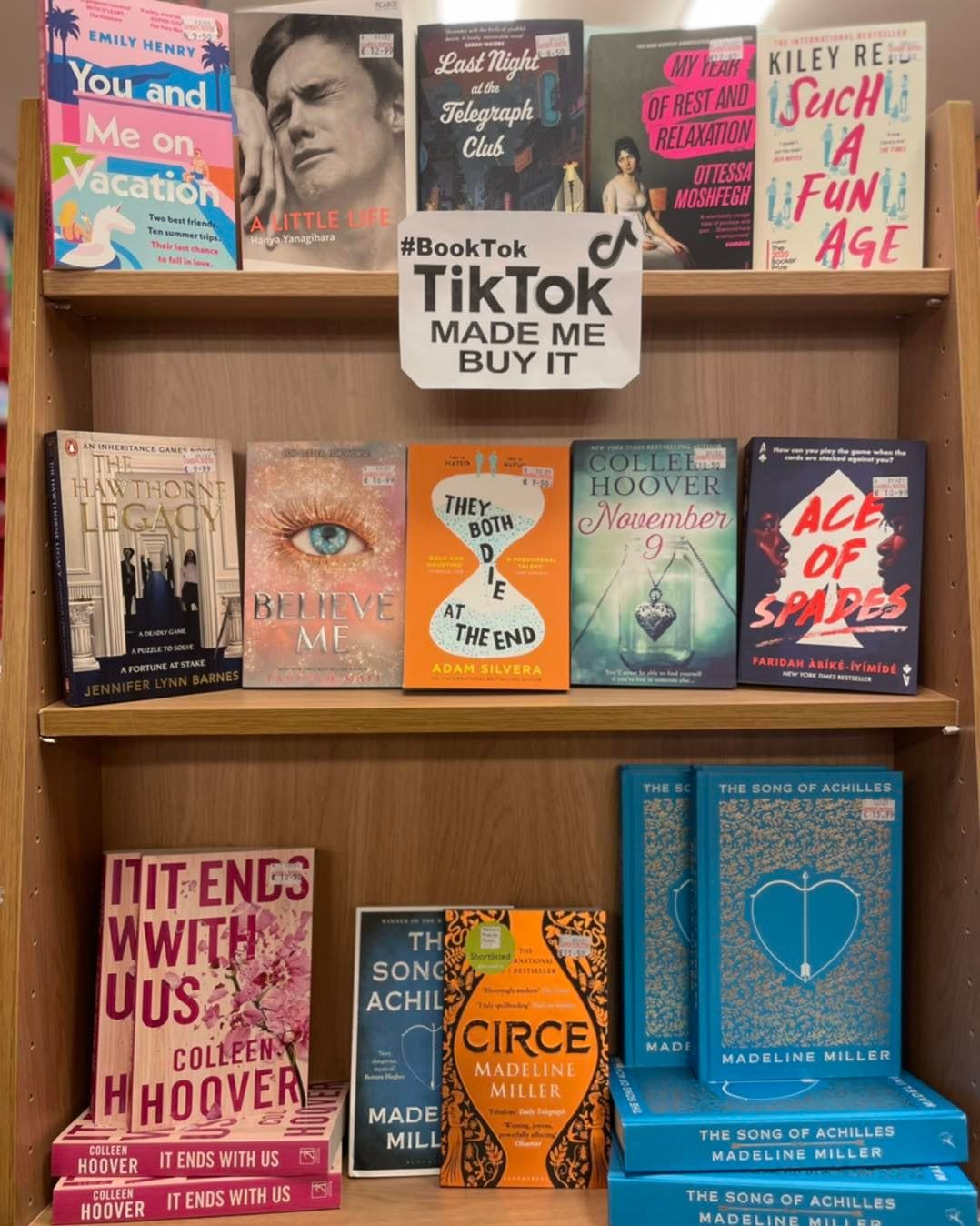
BookTok is also bringing younger readers back to physical bookstores. Inside, you’ll see BookTok shelves and tables front and center.
Barnes & Noble is opening 60 new stores in 2025. This will surpass the bookstore chain’s record of 57 openings in 2024. That’s a significant turnaround after more than a decade of downsizing, during which the company closed 150 locations between 2009 and 2019. Foot traffic at Barnes & Noble has been rising every month. People aren’t just buying books—they’re going back to bookstores.
Also Bloomsbury’s profits shot up 220%—the first year BookTok took off. Coincidence? Not a chance.
#BookTok’s Biggest Winners and Losers
Some brands saw what was happening and adapted.
Winners:
1. Barnes & Noble
For over a decade, Barnes & Noble was shrinking—closing stores, losing ground to Amazon, and quietly fading into the background.
Then BookTok happened, and Barnes & Noble leaned into it—hard. They:
Rolled out dedicated #BookTok tables in nearly every U.S. store
Launched BookTok-branded sections online
Let readers dictate what went on display—turning stores into fan-curated discovery zones
And it worked.
Foot traffic is rising month after month, and their #BookTok tables consistently rank among top-performing in-store displays.

What Can We Learn?
Retail has been in secular decline for years—but that doesn’t mean the products themselves are dead. What’s fading is centralized discovery.
TikTok makes it easier than ever to find and engage with passionate micro-communities.
Barnes & Noble succeeded by giving a digital fandom a physical home.
That’s the playbook: If you’re in retail, ask yourself—Is there a way for us to be a physical home for an existing vibrant community?
2. The Folio Society
The Folio Society is a publisher that specialized in collector’s editions—hardcovers designed to be gorgeous. We’re talking:
Cloth-bound hardcovers
Foil-stamped slipcases
Commissioned illustrations
Think of it as the Criterion Collection of publishing.
They were known for producing elevated editions of literary classics—Shakespeare, Austen, Tolkien. But they weren’t exactly built for viral trends.
But when BookTok’s obsession with fantasy exploded, they pivoted.
As fantasy and romantasy took off on TikTok, The Folio Society noticed something: unboxing videos were going viral. Readers weren’t just emotionally wrecked by the story—they also wanted to own a beautiful physical object that reflected how the book made them feel.
So what The Folio Society did:
They expanded their catalog to include BookTok darlings like A Court of Thorns and Roses, Dune, and The Song of Achilles
Leaned into aesthetic-driven sales, designing covers that would pop in TikTok feeds and on “Bookshelf Tour” videos
Prioritized limited runs with high price points (some editions retailing up to £1,000)—and they sold out
According to CEO Joanna Reynolds in an interview in The Guardian, fantasy and sci-fi were “gamechangers,” and their market under 25 is now nearly as large as their traditional over-65 audience. One unboxing video for The Song of Achilles helped the edition sell out within weeks—and it now has over 2 million views across platforms.
Sales have increased 55% since 2017–18, driven largely by this younger, online-first, fan-oriented audience.
What Can We Learn?
BookTok uncovered a market of deeply passionate fans who were underserved by the premium end of the market.
How can we extrapolate this trend to other markets that might have these dynamics?
I quote James Clear the way others quote Taylor Swift. Should his book also be on The Folio Society? Is there an opportunity to sell me concert tickets and passes to meet James Clear?
Gweneth Paltrow has GOOP home products. Will we see the rise of home goods brands from TikTok celebs? Should Target have a section for influencer-endorsed picks?
3. Little, Brown
Little, Brown is a publisher that partnered with BookMachine, a TikTok-savvy marketing agency, to run a campaign that combined influencer partnerships, paid ads, and real community engagement.
There’s no way to know for sure which book their campaign promoted, but best guess is that it was Circe by Madeleine Miller. Check out some of the #BookTok videos posted around then:
 Tiktok failed to load.
Tiktok failed to load.Enable 3rd party cookies or use another browser
The Strategy
Micro-influencer seeding. BookMachine handpicked creators under 10k followers—BookTok’s most trusted voices—and put the book into their hands. These creators are the emotional heartbeat of the platform: high engagement, niche trust, no performative gloss.
Paid amplification. Once content started organically performing, BookMachine backed the best videos with strategic TikTok ad spend, targeting similar audiences based on engagement patterns.
Organic storytelling. The creators weren’t given talking points. They were given books. The reactions—crying, gasping, ranting—were authentic. TikTok’s audience doesn’t want polish. It wants pain, obsession, and ugly crying. The campaign delivered.
Publisher-owned content. During the campaign, the account saw an 84% increase in followers, with improved organic reach and engagement.
The Results
The title featured in the campaign jumped 1,600+ spots on Amazon’s bestseller rankings, going from near-invisible to must-read.
Influencer videos hit hundreds of thousands of views, driven not by polish—but by genuine emotional reactions.
The content didn’t feel like marketing. It felt like obsession. Which is exactly what sells on TikTok.
Losers:
But there are those that treated BookTok like just another ad space—and not every viral hit delivers.
In the rush to cash in, some publishers and authors are pushing books to market too fast, leading to a flood of under-edited, formulaic releases that don’t live up to the hype.
These Violent Delights by Chloe Gong
Blasted for grammatical errors and poor editing
Left fans disappointed in what was supposed to be a high-caliber BookTok recommendation
The Spanish Love Deception by Elena Armas
Hailed as a must-read romance, but slammed for shallow characters and predictable tropes.
Readers expected something fresh but got the same overhyped formula.
The result? BookTok is powerful, but it’s also ruthless. A viral boost can sell thousands of copies fast—but if the book doesn’t deliver, readers won’t stay quiet about it.
The key takeaway? You can’t buy credibility on BookTok. You can’t manufacture trust. You can only earn it.
The TikTok Stats That Actually Matter for Marketing
“The reason TikTok is a great place for book promotion is due to a simple formula: algorithm + community + trends. The algorithm brings your bookish content to readers who have similar interests to you, which has helped the community element of BookTok to grow super fast. Following trends allows the content to feed into the larger picture of popular culture. This creates an accumulative effect of growth that results in more interest and “hype” around the book you are promoting. If you know how to work this formula to your advantage, you’re ahead of the game.”
— Niamh Wallace, BookTok creator (@booksarebrainfood) and BookMachine Marketing Executive
Everyone knows TikTok is big with over 1Bn users.
Users spend an average of 1.5 hours per day on the app, which is 2x the time spent on Facebook or Instagram, and 3X that of Twitter.
Comparison with Instagram: Micro-influencers (under 10K followers) average 18% engagement → Compare that to Instagram’s 4%. Smaller creators = bigger impact.
Comparison with Goodreads: In contrast, Goodreads, a leading book recommendation platform, receives approximately 87.3 million visits over a three-month period, averaging around 29 million monthly visits.

If you’re in marketing, startups, or building anything that requires people to care, here’s what you should learn from BookTok:
Extreme Emotion wins. Consumers trust raw, authentic, emotion. You want products and experiences (and influencer messaging) that is extreme.
Micro-influencers > traditional ads. TikTok’s algorithm doesn’t heavily weight follower count—it prioritizes engagement. That means content from a passionate micro-influencer with 10K followers will likely drive more impressions than a bland endorsement from a celeb with 5 million followers. When everyone starts on a level playing field, authenticity wins.
Sell emotional transformation, not products. People aren’t buying a drill - they are buying the holes it makes. With books—they are buying heartbreak, healing, identity, catharsis. You’re selling an emotional experience with a before and after.
“New” Matters Less than “New to Us” - There’s been plenty of discussion about how we are converging on a global monoculture - K-pop and watch bollywood films transcend geography. You can get avocado toast for brunch all over the world.
Our 3-dimensional world has collapsed-into a monoculture, and perhaps the fourth dimension (time) is next. BookTok shows that people are very happy to buy a 10 year old book even through it’s not “new” as long as it’s “new to us.” They care more about quality within their niche than broad-based newness.
Just this week, with The White Lotus ending, my wife started watching Mike White’s 2011 TV show Enlightened. I think we’ll see this trend more and more.




